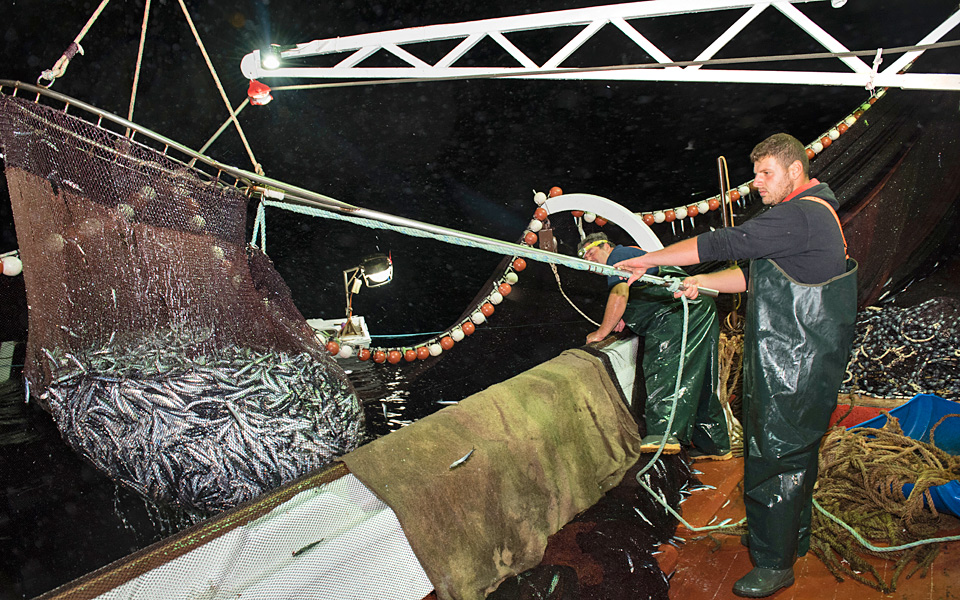In its effort to recover from the negative impact of the refugee crisis on local tourism, the island of Lesvos can call on the one major strength it has always had; its people. Unaffected by the development of the tourist industry, the natives of Lesvos do not welcome visitors to the island as tourists but as true guests. Compared to other islands, Lesvos has remained unmistakably traditional and genuinely human. Locals simply do not know how to be insincere in their approach to others. This natural hospitality represents yet another reason to visit an island that offers all-round authenticity, from villages set amid unadulterated natural beauty to the island’s pure folk tradition, still preserved in the squares, cafés, general stores, barber shops and, of course, fish markets, which seem to be found more frequently here than anywhere else. To find out more about one of the island’s most famous fish, the papalina sardine, and its journey from seiner boats to the market, we decided to visit at the height of sardine season.
The inner reaches of Greece’s third largest island are, unusually, washed by the sea. Kalloni Gulf, an extremely deep inlet, stretches all the way to the center of Lesvos, almost splitting the island in two and creating a watery border between the island’s east and west sides. The gulf area possesses a rich natural landscape; expect to see birdwatchers equipped with telescopes and binoculars discreetly positioned amid the pines, olive trees and reeds, especially during autumn and spring. The vast Kalloni wetlands are an unrivaled location for bird-watching, the practitioners of which are commonly referred to as poulades (bird people) by locals. The area is inhabited by 252 bird species, 87 of which are protected species. The relatively high temperature of the water within the gulf, and the abundant phytoplankton – autotrophic components of the marine community and a key part of the sea’s ecosystem – help make the papalina sardine species that thrives in these waters meatier, fattier and tastier than the related species roaming the open seas. At least, that’s the opinion locally, although it’s not shared by everyone on the island. “Don’t listen to it all. Kalloni sardines are a bit of a myth, a brand name. You can also get papalina sardines here in Gera – and they’re even better,” noted Thanassis Karantonis, a local fisherman and vice-president of a local fishing cooperative, referring to the island’s other gulf in the southeast.
We are talking to Karantonis on his seiner as he takes us out with him onto the Gulf of Gera. In the past, as many as 17 seiners, boats equipped for catching fish close to the surface, were active on the island. For a while, many fish market owners attempted unsuccessfully to vertically integrate by purchasing their own boats and hiring fishermen to work on their vessels. The owners took no part in the actual fishing expeditions but, instead, simply waited for catches to be brought in. The move was viewed as an intrusion into the fishermen’s market, and it failed. Consequently, just five seiners remain active today. “If you don’t grow up on one of these, but just go out and buy a boat and try to be the boss, you won’t make it. This is not a job for managers and bosses. The captain who is on board,” explains Karantonis matter-of-factly, “is the one who gets things done.”
“The relatively high temperature of the water within the gulf, and the abundant phytoplankton help make the papalina sardine species that thrives in these waters meatier, fattier and tastier than the related species roaming the open seas.”
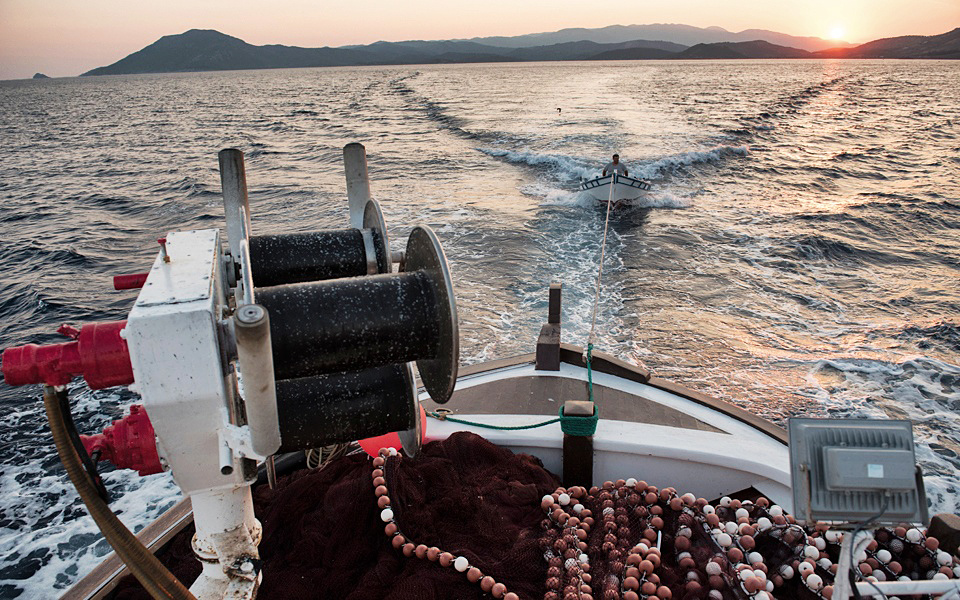
© Vangelis Zavos
“’This is not a job for managers and bosses. The captain who is on board,’ explains Karantonis matter-of-factly, ‘is the one who gets things done.’”
SEINER SETS THE FISHING NETS
We take off from the small pier at Pyrgi, a village on the coast of the gulf that consists of 80 fisherman’s homes spread over a slope. “Three brothers arrived here from Moshonisi [one of a group of islets east of Lesvos, just off the Asia Minor coast] and the whole village developed from that,” Karantonis tells us. The grandparents of many Lesvos islanders hail from Turkey’s west coast in Asia Minor. It is said these older folks had learnt the art of distilling ouzo there before bringing it to Lesvos, one of many new homes for ethnic Greeks as a result of Greek-Turkish population exchanges in the 1920s. A total of 17 distilleries operate on Lesvos today. “Our ancestors made ouzo and babies right over there,” remarks Stratis Karantonis, our captain’s son, pointing across the sea to Izmir – formerly known as Smyrni, when it was dominated by its ethnic Greek population – on the Turkish coast.
As the boat’s crew sets to work, I’m surprised by what I see. Seiner fishing seems like some sort of secret high-tech spy operation. The procedure begins by immersing powerful underwater robotic fishing lights into the sea to attract schools of fish. These lights are then switched off, one by one, drawing the fish even closer to the desired spot where the fishing net has been deployed. Technology has certainly made fishing easier. Indeed, experienced fishermen who have roamed the seas for decades know where to go for sardines, mackerel or anchovies, but technological support in the form of fathometers, GPS systems, sonar devices and robotic equipment helps them reach the right spots with far more precision. To make it even easier, all their underwater equipment is remote-controlled from the cockpit.
The sun goes down and the conversation turns stories from the past. The love of cured foods, including salted sardines, goes back a long way on this island. I am told that, in earlier days, poor men would come into grocery stores, handle cured products and then carefully caress a little salt onto their moustaches before heading off for a drink of ouzo. However, the preference for fish has apparently diminished over the years, and continues to do so, even on Lesvos, an island widely regarded as one producing some of Greece’s best fish. Speaking in a slightly sorrowful tone, Mitsos, one of the fishermen on board, attributes the trend to the altered preferences of younger people: “They don’t like fish – I don’t know why! They don’t know how to eat or prepare them. They don’t respect fish like us older folks.” At least eight small-scale fish curing and processing facilities operated on the island until the 1980s, but only two of these remain as a result of changing consumer trends, combined with the extended recession.
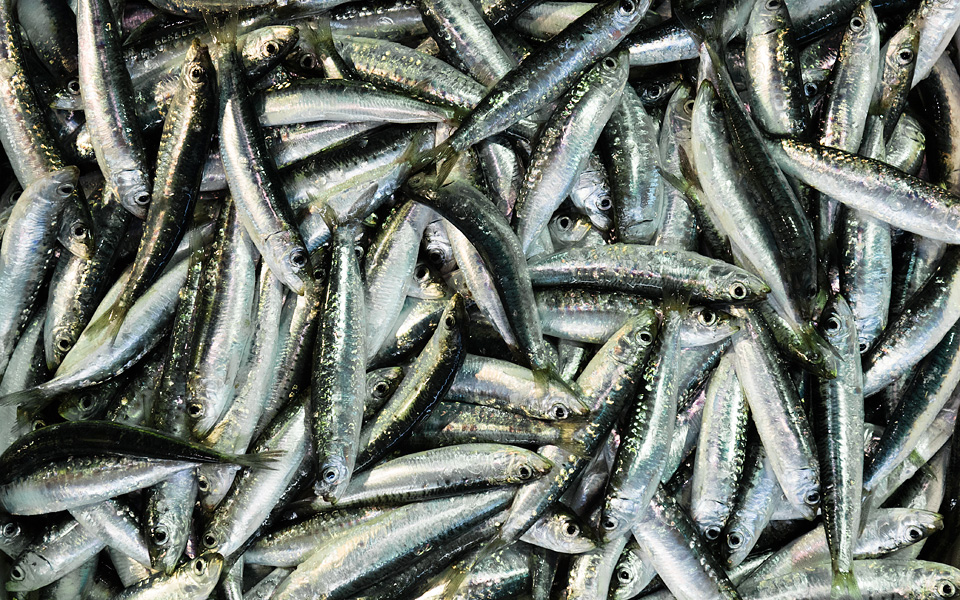
© Vangelis Zavos
“Of course, not all the sardines are eaten in cafés; papalina can also be enjoyed at home. ”
With the underwater lights at work misleading the fish into the hot-spot and the net deployed below, there is time for a break. The boat heads back for land and the crew insists on treating us a meal at their favorite taverna. “The preference for fish has apparently diminished over the years, and continues to do so, even on Lesvos, an island widely regarded as one producing some of Greece’s best fish.” The waiter serves us string beans, French fries, Greek salad, grilled anchovies, octopus, courgettes, and ladotyri, a traditional local hard cheese whose quality improves as it ages – as long as it is left immersed in olive oil in a cool place. Naturally, we have sardines as well, in two versions, cured and grilled. Though their bones are hair-thin, it is safest to eat these sardines bit by bit, unless, of course, you are Captain Thanassis Karantonis. Whole sardines disappear into his mouth and, moments later, bare bones reappear, like watermelon seeds when one is eating watermelon.
While less fish is being consumed overall, many of the island’s locals still eat sardines every day, either grilled with lemon and garlic or cured. Cured sardines and ouzo are enjoyed as a pre-lunch appetizer at traditional cafés that serve as unofficial museums with shelves are filled with old ouzo bottles, photos and various obsolete objects. Here, cards and playful teasing are all part of the daily ritual for groups of friends who gather for small talk and comfortable companionship. “If you don’t have [money], come and drink and when you do have, come and give. When you have and don’t give, don’t come to drink,” reads a sign in rhyming Greek at To Stavri, a café in the village of Agiasos.
Of course, not all the sardines are eaten in cafés; papalina can also be enjoyed at home. Wrapped in paper at the fish market and sprinkled with a good dose of salt, the sardines are left packaged for six hours to allow the salt to penetrate them. They are then rinsed, dressed with a little olive oil and are ready to eat – juicy and soft.
Good-quality olive oil flows as freely as water on Lesvos. The island is loaded with olive trees, covering the island as far as the eye can see. Bare land is seemingly nowhere to be found. Most islanders own at least one olive grove and focus on olives and olive oil or on olive by-products, including soaps and cosmetic creams. Numerous chimneys from now-defunct olive presses and soap-making facilities are scattered all over the island, reminding visitors of its productive past.

© Vangelis Zavos
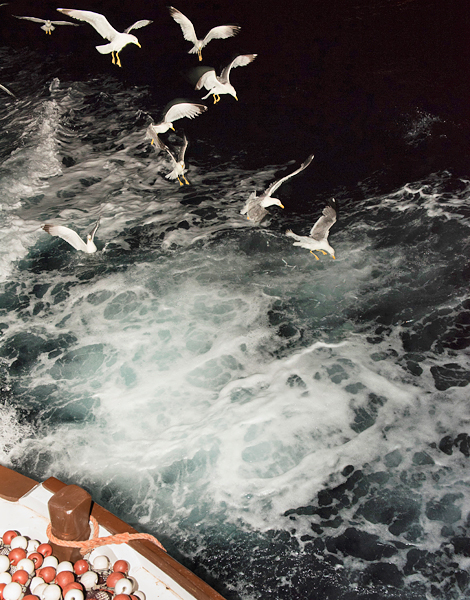
© Vangelis Zavos

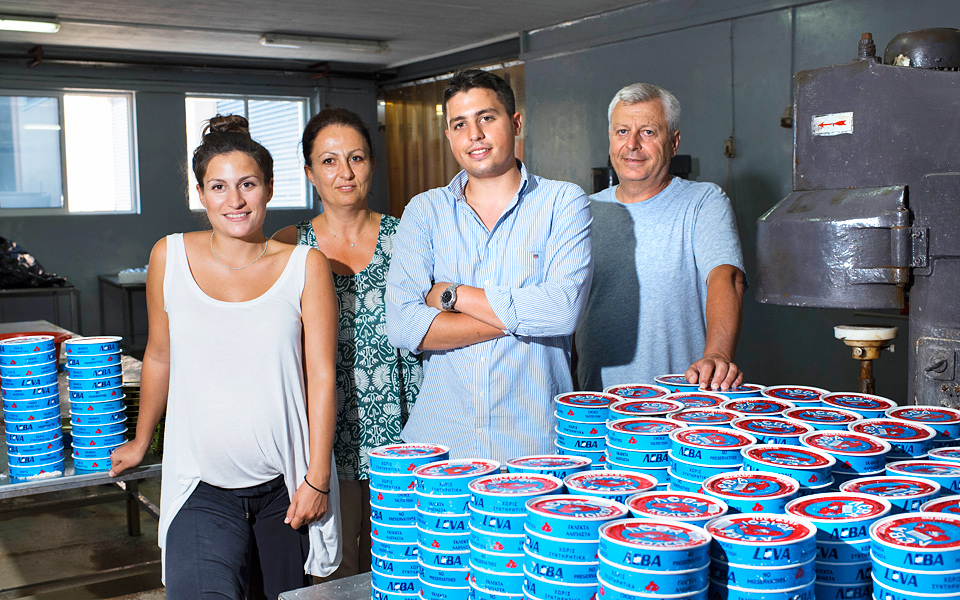
© Vangelis Zavos
BACK TO THE FISHING BOAT
We leave the taverna and return to the seiner. At the hot-spot, the fish have gathered around the enticing pool of light, the surrounding nets have restricted their movement and the sack – tightly-knit netting in the middle – is preparing to lift the stranded catch to the water’s surface and onto the deck. As the boat’s machinery gradually hoists the netting, a couple of fishermen dressed in waterproof gear move under the net crane. They are drenched by the flowing water and by tiny anchovies, fished unintentionally and now left wriggling on the deck to feed the seagulls. The big moment of the night has arrived. Six large containers lined with ice sit ready. The eyes of all crew members glow in eager anticipation, as if waiting on the delivery of a newborn child; they all want to see the catch, if there is one. The sea sparkles as the bulging net breaks the water’s surface. It’s a good night; a ton of sardines, anchovies, mackerel and shad, the latter to be used as bait. Once it is divided up and weighed by species, the crew informs the fishing cooperative of the news. Free-range sardines fetch as much as five euros per kilo, while papalina sardines sell for as much as 18 euros per kilo. “The fish market operates like the stock market,” our captain tells us. “The smaller the catch, the higher the price.”
We tie up at the port where a van belonging to the cooperative waits to collect the fish, loading them into nearly a hundred polystyrene boxes. Once taken from the port, the sardines are distributed all over the island. The small tavernas at Skala in the Kalloni area are among the places where fresh sardines may be enjoyed. Numerous smaller boats in this area go fishing for smaller sardine quantities using a net known locally as a sardeloni. Catches typically weighing between five and ten kilograms, a good day’s haul, are then sold in the area. Fish is also sold by traveling vendors who roam the coastline and mountain villages. These hawkers promote their products by calling out the day’s catch through the streets and alleys. Lesvos consumes roughly one and a half tons of sardine per day. Excess amounts are exported to the islands of Chios, Limnos and Samos, as well as to Athens and Thessaloniki.
While the cooperative’s van is being filled, are spontaneously distributed to many here, including those friends of the captain and his family who offered a hand on the dock and, in exchange, are being given a kilo or two to take home. The cats and the seagulls aren’t forgotten, either, and eat gratefully.
Around me on the busy dock, a new day is beginning. As the sweet morning light reminds my tired eyes that I have spent the entire night wide awake on a fishing boat, I can’t help thinking that life would definitely be more beautiful, and perhaps better, too, if we all had a little of the Karantonis family spirit in us.
KEEP IT FRESH!
Whatever isn’t sold at Mytilene market will go to Leva, the oldest active cannery on the island. It’s been operating since 1950 and distributes its goods throughout Greece and beyond. The northern countries were the first to discover salt-preserved Kalloni sardines, says the company spokesperson Panagiotis Valachis, then the rest of Europe and lately, America.
The remarkable thing about Leva is that while processing about 200 tons of sardines a year (70 of which stay on the island, 20 of which go abroad and the rest are sent across Greece) the cannery continues to salt and can sardines using the same methods as those found inside Mytilenian homes. “This work cannot be done by machines. It needs care and attention, to observe each and every sardine.” says 28-year-old EiriniBouchlis who has taken over the reins of the business started by her grandfather and continued by her parents.
The room where the fish are processed has mountains of salt flakes from the salt marshes of Kalloni, which is more salty, dense and well-known for its excellent quality. With this salt sprinkled over them, the sardines are placed in buckets and weighed down with up to one ton weights to press out all their liquids and fat. Larger fish take 8 months, the smallest just four days. Andreas is responsible for sprinkling them with water and brine every two days and to change the weights to make sure that all the fish are pressed uniformly. At the last table in the production line, the team fills the cans. One of the ladies deftly fillets two sardines and pops them into my mouth. “I’ve eaten a lot of salt these days,” I say. “It’s fruit.” she answers.
The canned sardines of Leva should be stored in the fridge even before opening them. Mytilene is the best place to eat the sardines, but if you can’t do that, be sure to accompany them with ouzo and good company. This is the simplest recipe to recreate your own Mytilene anywhere in the world.

